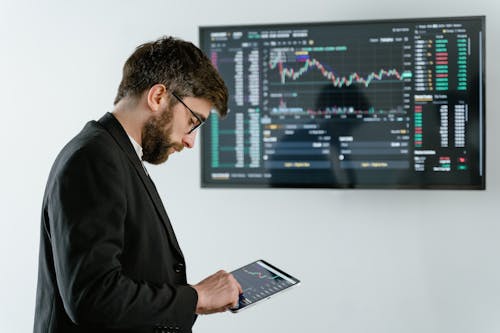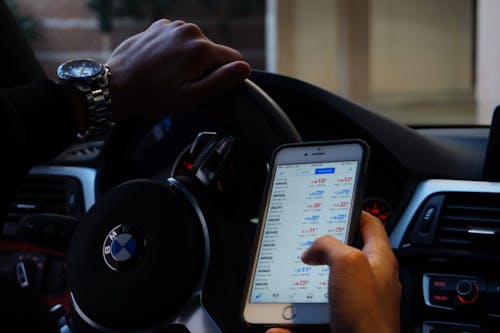How Mobile Trading Apps are Changing the Market In recent years, the financial landscape has undergone a seismic shift, and one of the primary drivers of this change is the rise of mobile trading apps. These apps, which enable traders and investors to buy, sell, and manage assets directly from their smartphones, are revolutionizing the way people engage with financial markets. Whether you’re trading stocks, forex, cryptocurrencies, or commodities, mobile trading apps have made trading more accessible, efficient, and engaging than ever before.

In this article, we will explore how mobile trading apps are changing the market, looking at the significant impact they’ve had on both individual traders and the broader financial ecosystem. From democratizing access to financial markets to increasing the speed and efficiency of trades, these apps are reshaping how we think about investing.
1. Democratizing Access to Financial Markets
One of the most significant impacts of mobile trading apps is their ability to democratize access to financial markets. In the past, trading was primarily restricted to institutional investors or individuals with significant capital and knowledge. To access the stock market, investors had to go through brokers, and many times, the process was complex and expensive.
Today, mobile trading apps have made investing accessible to anyone with a smartphone and an internet connection. Platforms like Robinhood, eToro, Webull, and Freetrade allow anyone to buy and sell stocks, forex, and other assets with little to no commission. These apps have eliminated many of the barriers that once made trading prohibitively expensive for everyday people, such as high brokerage fees and complex procedures.
Additionally, mobile trading apps have introduced features like fractional shares, allowing investors to buy a portion of a share, making it easier for people to invest in high-priced stocks like Amazon or Tesla, regardless of their budget. This has significantly broadened the pool of potential investors and opened up opportunities for people who were previously excluded from the market.
2. Increased Trading Speed and Efficiency
Another way mobile trading apps are changing the market is by increasing the speed and efficiency of trading. Before mobile apps, traders had to rely on desktop platforms or phone calls with brokers to place orders, a process that often involved delays. In contrast, mobile trading apps have streamlined this process, allowing users to place trades quickly and efficiently with just a few taps on their smartphone screen.
Mobile apps also allow traders to execute trades in real-time, which is particularly important in fast-moving markets like forex and cryptocurrencies. Instant order execution means that users can take advantage of market opportunities as soon as they arise, reducing the risk of missing out on potentially profitable trades.
With features like one-click trading, real-time price alerts, and push notifications, mobile apps have made it easier to stay on top of market movements and react quickly to changes. This has been especially beneficial for active traders who need to be agile and respond to market fluctuations in real-time.3. Empowering a New Generation of Traders
Mobile trading apps are particularly popular among younger traders, especially millennials and Gen Z, who have grown up in a digital-first world. These generations are tech-savvy, value convenience, and are increasingly interested in investing and managing their finances independently.

Mobile apps appeal to this demographic because they offer an easy-to-use interface, low fees, and the ability to trade whenever and wherever they choose. Many of these apps also include educational tools, social features, and gamification elements, which help engage and retain younger users. Apps like Robinhood have built a community of new investors, while platforms like eToro and Webull have incorporated social trading features, where users can follow successful traders and mimic their strategies.
This shift towards self-directed trading has resulted in millennials making up a significant portion of the market. In fact, research shows that millennial traders are more likely to use mobile trading apps than any other generation, and they are increasingly adopting trading as a way to build wealth, rather than relying solely on traditional retirement savings methods like pensions or 401(k)s.
4. Real-Time Access to Market Data and Analytics
With mobile trading apps, traders now have access to real-time market data, charts, and analytics at their fingertips. In the past, investors had to rely on expensive software or professional analysts to obtain in-depth market insights. Today, many mobile apps offer comprehensive technical and fundamental analysis tools for free or at low costs.
For example, apps like TradingView and Thinkorswim offer advanced charting capabilities, live news feeds, and indicators that allow traders to make more informed decisions. Mobile apps also provide customizable watchlists, real-time price updates, and stock screening tools, helping traders track assets that meet their specific criteria and make data-driven decisions.

The ease of accessing real-time data has increased the pace of trading, as investors no longer have to wait for reports or third-party services. This has created a more dynamic, competitive market where information flows freely and quickly, leveling the playing field for all traders.
5. Lowering the Barrier to Entry for Retail Traders
Mobile trading apps have made it easier and more affordable for individual traders to enter the market. Many platforms now offer commission-free trading, reducing the cost of participating in financial markets. This shift has made trading more appealing to retail traders who were previously deterred by high fees charged by traditional brokers.
Apps like Robinhood and Webull were at the forefront of this movement, offering zero-commission trading on stocks and options. By removing commissions and other traditional brokerage fees, these platforms have lowered the cost of trading and encouraged more people to participate in the market.
Additionally, many mobile apps have low minimum deposit requirements, enabling individuals to start trading with as little as $1 or $10. This low barrier to entry is making it easier for new investors to build their portfolios without risking significant amounts of capital upfront.
6. Introduction of Cryptocurrency Trading
Mobile trading apps have also played a crucial role in the mainstream adoption of cryptocurrencies. Cryptocurrencies like Bitcoin, Ethereum, and other altcoins were once niche investments, accessible only to a small group of tech-savvy investors. However, the rise of mobile apps has made cryptocurrency trading accessible to a much broader audience.

Apps like Coinbase, Binance, and Gemini have allowed individuals to buy, sell, and trade cryptocurrencies with ease, directly from their smartphones. These apps also provide educational resources to help beginners understand how cryptocurrencies work, as well as secure wallets for storing digital assets.
The ease of access to crypto markets via mobile apps has played a significant role in driving the adoption of digital currencies, with many retail traders now using mobile trading apps as a primary tool for cryptocurrency investment.
7. Better Risk Management Tools
Mobile trading apps have incorporated more advanced risk management features, empowering traders to better protect their investments. Tools like stop-loss orders, take-profit orders, and alerts help traders manage risk and automate their trading strategies. This is particularly beneficial for newer traders who may not have the experience or expertise to handle market volatility.

With the ability to set automated orders directly from a mobile device, traders can ensure that they don’t miss key opportunities or expose themselves to unnecessary losses. Many apps also offer margin trading and leverage, though it’s important to use these features carefully as they can magnify both profits and losses.
8. Greater Transparency and Security
Security and transparency are key concerns for mobile traders, and many apps are making strides in addressing these issues. Mobile trading platforms now offer multi-factor authentication, encryption, and secure payment systems to protect users’ funds and personal information.
Additionally, financial regulatory bodies in many countries are increasingly requiring mobile trading platforms to comply with strict rules that ensure transparency and fair treatment for traders. Many apps display real-time market data, asset values, and fees upfront, giving users more clarity on their trades.